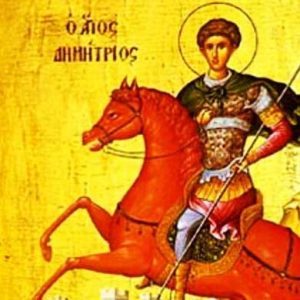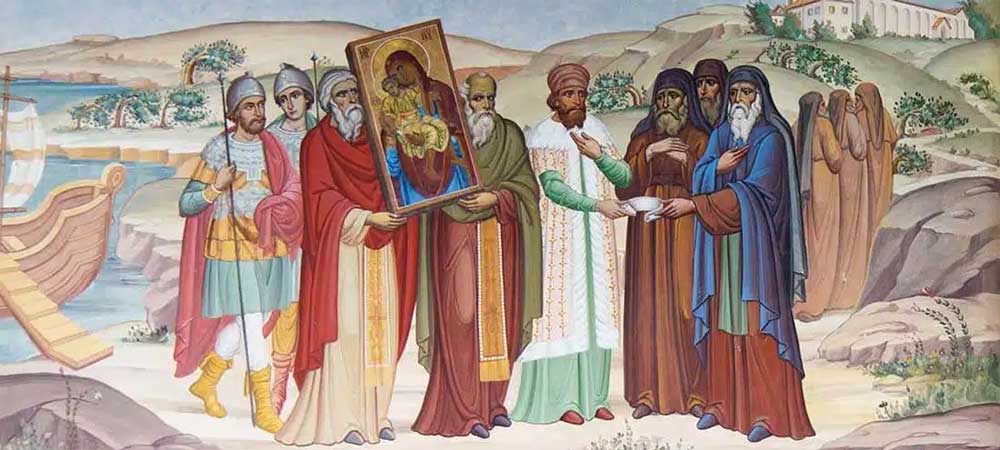Life of Saint Demetrius
 Demetrius was born around 280 in Thessaloniki, during the reign of Emperor Maximian, and came from an aristocratic family. He enlisted in the Roman army at a young age and rose to the rank of centurion at the age of just 22.
Demetrius was born around 280 in Thessaloniki, during the reign of Emperor Maximian, and came from an aristocratic family. He enlisted in the Roman army at a young age and rose to the rank of centurion at the age of just 22.
A studious and inquisitive nature, he sought the high and the true and found it in the Christian faith, of which he became a prominent preacher in Thessaloniki.
He formed a circle of young disciples and taught them the Bible in the underground arcades near the public baths of the city. During one such gathering, the pagans arrested him and brought him before the emperor Maximian, who was visiting Thessalonica. When the emperor asked him to renounce his faith, Demetrius replied: “I only believe in my Christ.” Maximian, enraged by the courageous attitude of his officer, ordered him imprisoned.
Meanwhile, one of Demetrius’ disciples, Nestor, presented himself at the stadium in Thessalonica, where Maximian was organizing athletic competitions, and asked to fight on behalf of the Christians with the ferocious and invincible wrestler Lyaeus, a pagan from Sirmium in Pannonia ( today’s Mitrovica of Serbia). Believing that he has the grace and help of God, Nestor entered the arena and not only defeated Lyaeus, but killed him, like David killed Goliath in the Old Testament.
Enraged by the defeat of his chosen one, Maximilian ordered the beheading of Nestor and the killing of Demetrius with spears. Demetrius was buried at the place of his martyrdom, where a magnificent temple was later built in his honor. Myrrh flowed from his tomb, hence the name Myroblytis.
Rarely has a saint been so closely identified with a city, as Saint Demetrius is with Thessaloniki. He was always considered by the Greeks to be the guard of the city, who together with the people fights against the Slavs, Avars, Arabs, Normans, Franks, Turks and other barbarians. It is no coincidence that the Greek army liberated Thessaloniki on the feast day of Saint Demetrius (October 26, 1912), a fact that was considered a miracle.
Saint Demetrius is often depicted in front of Maximian, in prison, blessing Nestor. In addition, because Saint Demetrius is also one of the soldiers and contemporary patron of Thessaloniki, who many times saved from various dangers, representations in which the saint is depicted as a soldier, whether on foot or on horseback, are common in Orthodox iconography.
In this image, Saint Demetrius is shown as a rider in military uniform on a red horse, killing the Bulgarian tsar Skylogiannis with his spear. It is about the miracle that took place in October 1207 outside the walls of Thessaloniki.
The tsar of the Bulgarians Ioannitzis, whom the Byzantines called Skylogiannis, was according to tradition killed by Saint Demetrius, when he was besieging Thessaloniki. In the face of Saint Demetrius, Thessaloniki always sees its protector, its support. (The liberation of the city from the Turks in 1912 coincided with the feast day of our saint).
St. Demetrius is rightly called by the hymn writer of the Church “the great guard of Thessaloniki, the leader in danger the excellent, the promachos the statesman” (Canon second). In another Canon, composed by Simeon of Thessaloniki, Saint Demetrius is reported to have said to his protected homeland, Thessaloniki “… do not be afraid, my country, I have possessed, your enemies for I will defeat everything in Christ and protect you we have honored”.
It was rightly observed that of all the icons of Saint Demetrius, the icon of the saint on horseback was loved the most, because it embodies the Greek ideals of youth and levity. In the minds of the faithful, Saint Demetrius is not only, according to the hymn writer, “an invincible bulwark and an unbreakable foundation and patron, settler and defender” of the city of Thessaloniki and “in many and many dangers, the leader of the Thessalonians”, but also an omega defender of worldly.
